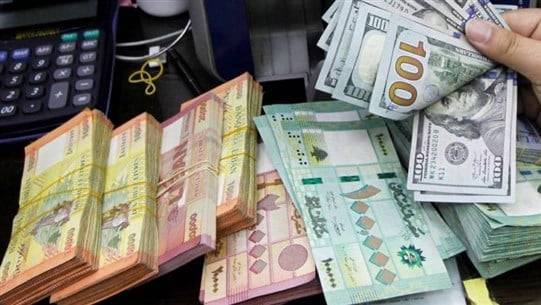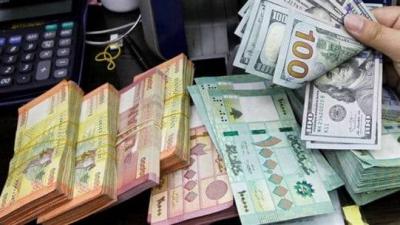Lebanon's financial markets are anticipating significant developments this week that could lead to substantial changes in the monetary landscape, particularly concerning the exchange rate of the Lebanese pound and the pricing of withdrawals from dollar-denominated savings. Additionally, there is a push towards the practical implementation of a restructuring plan for the banking sector, which is a critical item on the list of conditions set by the International Monetary Fund (IMF) team in the initial agreement made with the Lebanese government six months ago, in preparation to finalize the file for submission to the Board of Directors.
It has become apparent that there are several exchange rates for the dollar in Lebanon; the most notable being the official rate, which remains at 1,500 pounds, the black market rate which has surpassed 40,000 pounds, and the Sayrafa platform rate at 8,000 pounds. According to exclusive information gathered by "Asharq Al-Awsat" from relevant sources, the Central Bank is planning to issue a series of new regulatory circulars starting mid-week. These will specifically involve lowering the official exchange rate of the national currency and detailing its applications regarding withdrawals from deposits and banks' balance sheets, with the changes taking effect alongside the implementation of the customs dollar rate at the beginning of next month, after being raised approximately tenfold from 1,507 pounds to 15,000 pounds.
It is likely, according to the information, that there will be a commitment to adopting a new exchange rate aligned with the import dollar rate at 15,000 pounds, with a minor possibility of a temporary rate of 12,000 pounds; this is the current pricing applied to beneficiaries of Circular No. 158, which allows for a monthly withdrawal of 800 dollars, split equally between cash dollars and cash conversion in pounds via electronic payment cards. In both cases, the corrective benefit will extend to withdrawals from savings, presently priced at 8,000 pounds per dollar. The adjustments will be accompanied by a reduction in monthly withdrawal quotas to prevent an excess supply of liquidity in pounds.
Banker Najeeb Smahan considers that "any move to correct the monetary distortions caused by multiple exchange rates will certainly fall into effective approaches for developing crisis management methodologies given the massive financial crises the country and its economy have been suffering for three years." This will also help alleviate the burdens and exchange losses incurred by depositors in banks, as well as meet the requirements of the initial agreement with the IMF and push towards shaping the final agreement that includes a financial program worth 3 billion dollars, and most importantly, re-opening the doors to external financing from donors and financial markets alike.
Smahan emphasizes, in a statement to "Asharq Al-Awsat," that "bank managements are effectively cooperating with all measures and procedures issued by the monetary authority. They are collaborating with all its components, especially the governorship, the central council, and the banking control committee, aiming to establish the best principles and practices that ultimately lead to reforming the banks' conditions and restructuring their balance sheets, which have themselves been distorted due to difficulties in managing liquidity, monetary and financial pressures, and the erosion of capital. Additionally, there have been campaigns to 'demonize' the sector, loading it and depositors with the largest portion of the financial gap estimated by the government at around 72 billion dollars."
The discussions regarding changing the official exchange rate of the pound have indeed encountered political issues and ambiguities regarding the authority of the decision and its link to the comprehensive recovery plan the government intends to present to Parliament. This contradicts the text found in the recently approved budget law, which states that "unifying the exchange rate has become a pressing necessity and is a fundamental entry point for any economic recovery plan, which will subsequently restore confidence in the financial system."
In his latest remarks, referred to as an "account statement," Finance Minister Youssef Khalil noted regarding the status of the national currency: "I will just say that countries with multiple exchange rates are economically sick." He thus affirmed: "We have started the process of unifying the exchange rate. Strategically, the exchange rate of the pound should align with the real dollar rate, which is perhaps the simplest means to curb smuggling and eliminate speculation at the expense of the pound's value, thereby benefiting a minority of monopolizers at the expense of the general populace. This is guided by the economic recovery plan and in coordination with the IMF, where we have prepared as a government an initial package of structural reforms, including the banking secrecy project, capital control, the 2022 budget which includes fiscal corrections, customs dollar, and exchange rate unification."
In conclusion, according to banking sources, it appears that "the government’s opinion has finally settled on the responsibility of the central bank in determining the exchange rate and its applications." This can be interpreted as a "way out of the exchange of authority between the central bank and the Ministry of Finance," which had officially announced (infamously) at the end of last month that it agreed with the central bank to adopt a rate of 15,000 pounds for every dollar, based on the provisions of articles (75) and (83) of the Money and Credit Law, along with other regulatory and operational texts issued by the Central Bank of Lebanon. The financial and monetary authorities are to work on containing any repercussions on the social conditions of Lebanese citizens, as well as assisting the private sector in transitioning smoothly to the newly adopted exchange rate.
It was learned that specific instructions regarding the new pricing applications on banks' balance sheets will accompany upcoming adjustments to the exchange rate, ensuring gradual absorption opportunities by isolating losses in both asset and liability categories and recording them in an "off-balance sheet" entry. This provides banks' management with practical and temporal leeway to mitigate these losses by injecting new liquidity through private funds, operating profits, and resources resulting from loans and financing, in addition to potential future increases in the values of government bond portfolios.
Moreover, it has been noted that the Central Bank of Lebanon preemptively issued Circular No. 646, which allows borrowers, without prior approval, to make early repayments on all housing loans and loans related to continuing education in higher education institutions, as well as environmental loans, without imposing any penalties on the client for early repayment before seven years have passed since the housing loan's implementation.




